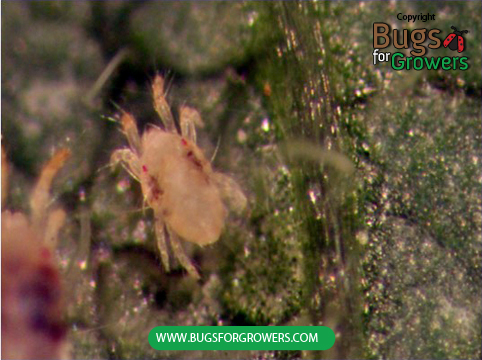Two-spotted spider mite of Hemp
Hemp mites are called as two- spotted spider mites, Tetranychus urticae because they have two red spots on their thorax (Photo 1). Although these mites are very tiny (1/20 inch long, oval shaped and brownish to yellowish in color), they cause serious damage to hemp plants by sucking juice from their leaves and succulent twigs. Heavily infested leaves generally turn yellow, appear mottled and speckled, and eventually they dry and drop off the plants. These severely damaged plants generally remain stunted and cannot produce new leaves that in turn reduces crop yield. In addition to direct feeding damage, two-spotted spider mites produce webbing on the leaves and small branches with the fine strands that reduces the quality and yield of hemp. Thus the damage caused by two-spotted spider mites can cause in millions of dollars loss to hemp industry.

Life cycle of two-spotted spider mites
Two- spotted mites generally overwinter as mated females. When temperature is optimum, these females lay hundreds of translucent and spherical eggs on the leaves of their host plants. Then these eggs hatch into small larvae that become adults within 7 days. Under favorable climatic conditions, two-spotted spider mites can complete one generation within 2-3 weeks.
Predatory mites, Amblyseius andersoni.
Currently predatory mites Amblyseius andersoni are used as biocontrol agents for the organic control of two- spotted spider mites in the hemp production. This is because Amblyseius andersoni are very active in finding and feeding on two-spotted spider mites. Amblyseius andersoni can survive, reproduce and develop at a wide range of temperature between 6-40°C (43-104°F) in the greenhouses and growth houses. While feeding on the two-spotted spider mites, predatory Amblyseius andersoni mites continuously reproduce by laying oval shaped and colorless eggs. These eggs hatch into small mites (larvae/ nymphs) and become adults within 2-3 weeks. During development and after becoming adults, these predatory mites continuously feed on the eggs, nymphs and adults two- spotted spider mites.
When and how Amblyseius andersoni mites should be released?
- Amblyseius andersoni mites are supplied as adults in a container containing a mixture of bran or vermiculite.
- Hang these containers to plants at every 5-12 feet in the greenhouses or growth houses/chambers.
- Because Amblyseius andersoni mites are very active, they will walkout themselves out of container and disseminate throughout the greenhouse to seek various stages of two-spotted spider mites as their food.
- As a preventive control measure, Amblyseius andersoni mites should be released when there is a very low population of two- spotted spider mites.
- As a curative measure, Amblyseius andersoni mites should be released when there is a very high population of two- spotted spider mites.
- Release Amblyseius andersoni mites when temperature and relative humidity is between 6- 40°C (43-104°F) and 40-60%, respectively.
How does Amblyseius andersoni kill two-spotted spider mites?
After application in the greenhouses or nurseries, Amblyseius andersoni mites immediately start voraciously feeding on all the different stages of two-spotted spider mites.
How many Amblyseius andersoni mites should be released?
For the effective control of two- spotted spider mites, it is recommended to follow the schedule given below.
- Release 4-5 predatory mites/square feet (0.1 sq. meter) area bi-weekly, 2-3 times.
